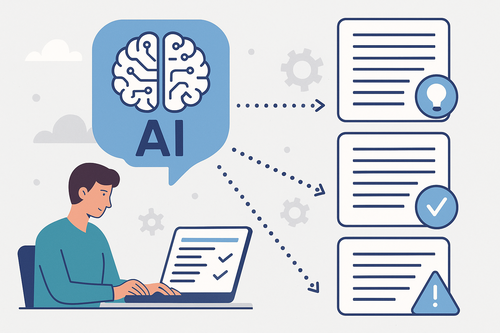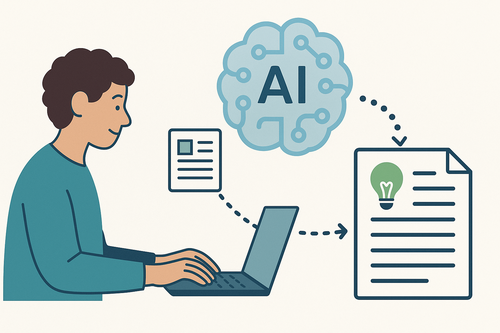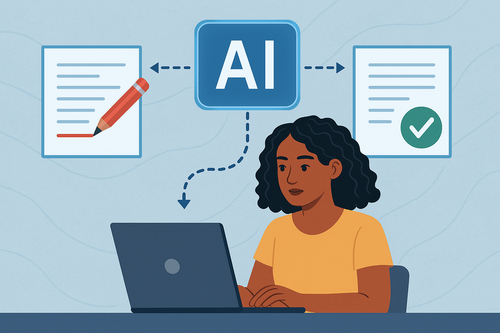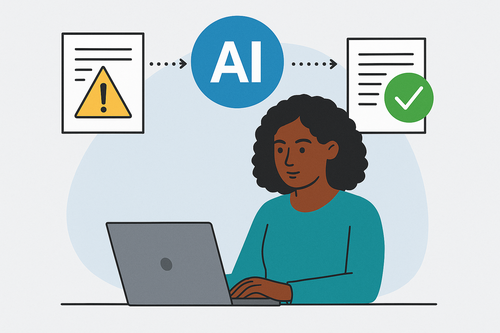We’re surrounded by promises that generative AI will change everything about technical communication. The tools are powerful, no doubt, but also unpredictable, opaque, and often misused. Most conversations about AI in our field swing between two extremes: total automation and total avoidance. Both are wrong.
The truth is that AI is already in our workflows, whether we invited it or not. It appears in writing tools, content platforms, and project management systems. The challenge is not whether to use AI, but how to use it responsibly so that it supports clarity and accuracy instead of undermining them.
This article focuses on three areas where AI can genuinely help technical communicators do their work better: drafting, revision, and quality assurance. These are practical, everyday processes, not futuristic scenarios. My goal is not to sell another AI tool or preach resistance. It is to show where the technology fits, where it fails, and how we can use it to strengthen, rather than replace, human expertise.
Workflow 1: AI-assisted drafting
Most technical communicators already know the pain of creating first drafts. The blank page is not inspiring; it is intimidating. Drafting is where projects stall, deadlines slip, and documentation backlogs grow. This is also where AI can help, but only if we give it the right work to do.
AI-assisted drafting is not about having a model write an entire article or user guide from scratch. That kind of automation usually produces vague, inaccurate, or overly generic text. Instead, AI is useful for what I call scaffold drafting. In this approach, writers feed the model structured materials such as templates, outlines, or snippets of legacy documentation and ask it to build a draft that fills in predictable gaps.
For example, imagine your team maintains a set of installation guides that follow the same pattern: prerequisites, setup, verification, troubleshooting. Rather than rewriting that structure every time, you can prompt an AI system with an existing document and a new product description. The result will not be perfect, but it gives you a starting point that saves hours of formatting and basic phrasing.
The key is to treat the model as a collaborator, not a coauthor. You decide what goes into the prompt and what stays out. You also decide which parts make it into the final draft. Every AI-generated sentence still needs a human review for accuracy, consistency, and tone. Technical communication is too important to outsource completely.
The biggest risk with AI-assisted drafting is letting speed replace sense. It is tempting to push a button and call the result good enough, especially under deadline pressure. That is how inaccuracies slip in and credibility erodes. A better approach is to build an internal checklist that identifies what kinds of content can safely be generated, what must always be verified, and who signs off before publication.
When used this way, AI becomes another writing tool, like a grammar checker or a style guide, rather than a threat. It accelerates routine work so writers can focus on what matters most: understanding users, communicating clearly, and ensuring the final document does its job.
Workflow 2: AI-supported revision and editing
Revision is where most technical content becomes readable. Writers know how much time it takes to simplify complex sentences, correct inconsistencies, and make sure every instruction fits the user’s level of knowledge. These are tasks that AI can support effectively, provided we use it as a second set of eyes rather than a replacement editor.
Modern AI tools can help spot issues that humans often overlook after multiple review cycles. They can flag unclear phrasing, repetitive wording, or deviations from a style guide. Some systems can even check for terminology drifts across large documentation sets. Used carefully, these tools can make revision faster and more consistent without changing the writer’s judgment or voice.
A simple example is using AI to simplify a dense paragraph from a knowledge base article. Instead of rewriting it entirely, you can prompt the system to make the text easier to read for a specific audience, such as field technicians or new users. The output might not be ready to publish, but it can help identify where sentences are too long or explanations too abstract.
However, revision is also where AI errors are easiest to miss. When a system “improves” a sentence, it may also remove a key technical term or alter a process step. Writers who rely too heavily on automated edits risk losing accuracy in exchange for smoother prose. That tradeoff is never acceptable in technical communication.
The safest method is to create a two-step process. First, let AI suggest edits in a clearly marked environment, such as a separate document or tracked changes view. Second, review every proposed change manually before accepting it. This approach keeps the control with the writer while still taking advantage of the system’s speed and pattern recognition.
Used in this way, AI-supported revision becomes an assistive technology, not an authority. It helps writers identify weak points, maintain consistency, and apply style standards across documents. The result is cleaner, clearer text that still reflects human expertise and accountability.
Workflow 3: AI in quality assurance
Quality assurance is the last defense between flawed documentation and frustrated users. It is also one of the most repetitive and time-consuming stages of the content lifecycle. Technical communicators check links, formatting, terminology, metadata, and accessibility details that often escape attention earlier in the process. AI can make this work faster and more reliable, but only if it is integrated into a structured review process.
Many QA tasks follow clear, rule-based patterns. For example, AI systems can scan large documentation sets to identify inconsistent product names, missing alt text, or broken cross-references. They can also detect tone mismatches between sections or flag language that may not meet accessibility guidelines. When configured correctly, these systems act like tireless proofreaders that never get distracted.
The risk is assuming that automation equals accuracy. AI can find obvious problems but often misses subtle ones, such as contextual errors or mismatched versions of product information. It can also generate false positives that waste time instead of saving it. That is why human oversight must remain part of every AI-enabled QA workflow.
A practical approach is to let AI handle the first pass. For example, it might generate a report listing potential inconsistencies or missing metadata. The writer or editor then reviews that list, decides which findings are legitimate, and applies corrections manually. This method keeps the efficiency benefits of automation without giving the system final authority over content quality.
AI can also improve collaborative QA. Teams can use shared AI dashboards to track recurring issues or measure improvements across document releases. The data these tools provide can highlight patterns that humans might overlook, such as persistent terminology errors or common accessibility failures.
The goal is not to let AI certify quality but to use it as an early warning system. When paired with a disciplined human review process, AI helps writers maintain consistency and reliability across large documentation sets. In the end, the technology should serve the same purpose as every other tool in technical communication: ensuring users get accurate, usable information every time they open a page.
Cross-workflow principles: How to use AI responsibly
The success of any AI initiative in technical communication depends on how responsibly it is applied. The workflows described so far – drafting, revision, and quality assurance – can all deliver real benefits, but only when guided by principles that protect clarity, accuracy, and accountability. Without those guardrails, AI becomes another source of noise rather than a tool for improvement.
The first principle is clarity. AI should never obscure meaning or introduce unnecessary complexity. Writers must always verify that generated or revised content still serves its audience and that explanations remain specific and concrete. A perfectly grammatical sentence that confuses readers is not an improvement.
The second principle is accuracy. AI systems cannot verify facts or interpret technical details with the precision of a subject matter expert. Any information produced or edited by a model must be checked against source materials and validated through established review channels. This step is not optional.
The third principle is accountability. Human writers and editors remain responsible for the content they publish, regardless of how it was created. That responsibility extends to ethical and legal considerations such as data privacy, bias mitigation, and compliance with organizational standards. Every AI-driven workflow should include clear documentation of how the system was used and who approved the results.
The final principle is transparency. Teams should share their AI practices openly within their organizations. This builds trust with stakeholders and prevents misuse born of misunderstanding. When people know what AI is doing and why, they are more likely to support its use.
Responsible adoption is what separates innovation from recklessness. The goal is not to prove that AI can write or edit, but to show that humans can use it wisely.
Conclusion: A pragmatic path forward
AI will continue to evolve, and so will the conversations around it. The challenge for technical communicators is to stay grounded. We do not need to predict the future of AI to use it effectively today. What we need are processes that make sense, protect users, and respect the expertise that defines our field.
The three workflows discussed in this article – drafting, revision, and quality assurance – are not theoretical experiments. They are practical entry points where AI can make real work easier without weakening the standards of clarity and precision that users depend on. The key is to start small, measure results, and keep humans in charge at every stage.
AI is not going to replace technical communicators. It will, however, reshape how we spend our time. If we use it wisely, we can focus less on mechanical tasks and more on solving user problems, improving accessibility, and designing better information systems. That is a future worth working toward, and it begins with careful, deliberate practice today.




